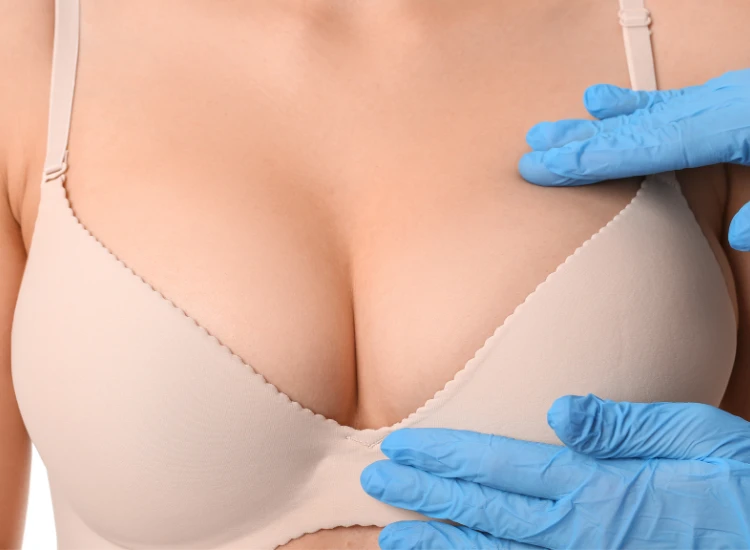Breast asymmetry can basically be defined as the situation where there are differences in shape, placement and size between the two breasts. Many women have breast asymmetry that is noticed without detailed examination.

Breast asymmetry can basically be defined as the situation where there are differences in shape, placement and size between the two breasts. Many women have breast asymmetry that is noticed without detailed examination. Breast asymmetry does not usually indicate a different problem. However, it should be kept in mind that asymmetries noticed in the mammogram may be due to formations such as a mass in the breast and therefore should be examined in detail.
Breast deformity is a condition that should not be confused with breast asymmetry. Breast deformity is also referred to as "tuberous breast". Although this disorder is a congenital anomaly, the person must enter adolescence and breast enlargement in order to be noticed. Asymmetry between the two breasts in the condition called tuberous breast is a very common condition.
However, this deformity is defined as a rare condition characterized by the fact that the base of the breast is narrower than it should be, and the areola area is wider than normal. While different breast aesthetic techniques are used in the correction of breast asymmetry, the breast deformity condition called tubular/tuberous breast can be eliminated by placing a prosthesis on the breast and reshaping the breast.
Breast asymmetry is the situation where there are differences in volume, posture and shape between the two breasts of the person. Breast asymmetry is seen in 5 out of every 10 women. The occurrence of this situation can be due to many different reasons. Breast asymmetry may occur due to factors such as trauma and hormonal changes.
Juvenile Hypertrophy or Breast Hypertrophy, which is rarely seen and defined as a serious difference in size between two breasts, can cause noticeable breast asymmetry. In the case of rapid growth of the breast, an increase in adipose tissue is usually observed.
Breast Asymmetry;
Genetic factors,
Pregnancy and/or breastfeeding,
Menopause,
Hormonal changes,
Weight loss or weight gain,
Irregularities in the formation of the rib cage,
Poland syndrome,
Tuberous breast,
It may occur due to reasons such as amasti (congenital absence of the breast).
Asymmetry is divided into four as global asymmetry, focal asymmetry and developing asymmetry. Since the images of the chest area are one-dimensional in asymmetry, the results may not be very reliable. For this reason, three-dimensional imaging technologies are used. Global asymmetry means that one breast is more voluminous and denser than the other breast.
It can be seen after hormonal changes. Focal asymmetry includes the intensity of two mammography scans. The developing symmetry also shows the change that occurred between the previous examinations and the most recent examination. The density may be new or increased. These findings may be sufficient to suspect a tumor.
Breast asymmetry due to trauma is an asymmetry that does not develop spontaneously and occurs due to a reason. It can occur after an accident, infection, or injury, such as radiation exposure to one side of the chest area. Obstruction of the milk ducts due to infection is quite common in women who are breastfeeding.
Breast asymmetry is a common condition and is often thought of as an aesthetic problem. However, in some cases, a different size of one breast compared to the other can be a sign of breast cancer. Especially in people with a family history of breast cancer, asymmetries should be approached more carefully. Because the risk of developing breast cancer is 2 or 3 times higher in people who have a history of breast cancer in their first and second degree relatives.
Asymmetrical breast tissue can be defined as the fact that the breast tissue in a breast is more voluminous or more dense than the surrounding tissues. It is considered normal to have asymmetry in the breast tissue, but examination is required after the finding. Asymmetrical tissue may indicate a malignant fibrograndular tissue or lesion. With the additional examination to be made after the finding, the cause of the asymmetric breast tissue can be determined.
Ectopic breast tissue is the presence of structural tissues in a developed breast along the imaginary milk line running from the nipples to the groin. In the embryo, this line appears as a series of double buds that are the basis for future mammary moles in mammals. In humans, when the embryo reaches 20 mm in size, it all disappears. Ectopic breast tissue may very rarely contain benign or malignant cells. In addition, it can also cause cosmetic problems in patients.
Breast asymmetry is a common condition and is often thought of as an aesthetic problem. However, in some cases, a different size of one breast compared to the other can be a sign of breast cancer. Especially in people with a family history of breast cancer, asymmetries should be approached more carefully. Because the risk of developing breast cancer is 2 or 3 times higher in people who have a history of breast cancer in their first and second degree relatives.